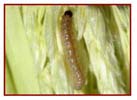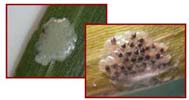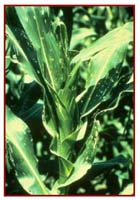European Corn Borer
Ostrina nubilalis Hubner
The European corn borer can be found in areas east of the Rocky Mountains from the Gulf Coast to southern Canada. Its host rangehas more than 200 species of plants, including both agronomic and horticultural crops and many common weeds. It is one of the major economic corn pests in Illinois. Losses due to European corn borer damageand control costs often exceed one billion dollars in the United States. However, the impact of this insect on corn yield is often underestimated due to the plant's ability to tolerate feeding, lack ofscouting efforts, and fluctuations in corn borer densities from year to year.
Description
Early instars of European corn borers are tiny larvae, approximately 1/32 to 1/16 inch long, with translucent white bodies and brown heads. As the larvae mature, the become flesh-colored with blackish heads. Larvae are ¾ to 1 inch long and have two distinct brown spots (tubercles) on each abdominal segment. European corn borer larvae have three pair of true legs behind the head and five pairs ofprolegson their abdomen. Pupae are brown, ½ to ¾ inch long, and have a rounded head region and abdomen area tipped with a tiny hook. Male and female corn borer moths are similar in appearance. moths have alternating yellow and brown wavy lines across each wing, although the males have a darker wing pattern. Females lay eggs in clusters (average 23 eggs per cluster), but they may lay as many as 60 eggs per cluster. One egg is about the size of a pinhead. Egg masses are creamy white when first laid, but become more translucent as time goes on. As larvae mature in the egg, the black/brown color of the head capsule is visible through the egg. This is known as the blackhead stage.



European corn borer larva European corn borer adult European corn borer egg masses
Life Cycle
| Biology of European Corn Borer |
|
|---|---|
Moth longevity |
1 to 2 weeks |
Pre-oviposition period |
2 to 3 days |
Egg-laying period |
7 to 10 days |
Each moth lays... |
~2 egg masses/night |
One egg mass |
~23 eggs |
Eggs/female |
~400 |
Larval hatch |
3 to 7 days |
Larval survival |
10 to 20% |
# larval instars |
5 |
Mature larvae (fifth larval instar) overwinter in corn stalks, stems of plants, or plant debris in or on the soil. They pupate in the spring when temperatures reach 50°F and emerge as adults in late spring. Females lay eggs for the first-generation in cornfields or on secondary grass hosts.
Eggs hatchin approximately 5 to 7 days. Young larvae move to and, depending on the growth stage of the corn plant, feed in the whorl, ear, or leaf collar. As borers mature to the3rdor 4thinstar, they begin to bore into the stalk and midribs or leaves where they develop and pupate. They emerge as moths in a week to ten days after pupation. Moths gather around field edges and grassy areas, referred to as "action sites." Action sites are areas that contain dense vegetation and are very humid; these conditions are optimal for moths to mate, rest and drink water. Moths begin to lay eggs fora second generation in cornfields that are tasseling and on late-planted corn. Approximately 90% of eggs are deposited on the undersides of the ear leaf and the three leaves above and below the ear. The second generation larvae pass through the same stages as the first generation. A third generation may occur in the southern third of Illinois. However, the fifth instar of the second generation generally enters diapauseto overwinter. Diapauseis an inactive stage where no growth occurs and can be induced by acombination of factors such as decreasing day length, temperature, and food quality.
Injury
Corn that is less than 15-18 inches tall is not very susceptible to corn borer injury. Plants this height possess a compound called DIMBOA that prevent larvae from establishing. Larvae that feed on smallcorn generally fail to establish and wander off the plants and die. As plants mature, the concentration of DIMBOA decreases, andthey become more susceptible to corn borer injury. Early planted corn is most susceptible to larval feedingby first-generation of borers.

Corn borer larvae feed on all parts of the corn plant except the roots. First-generation larvae are found feeding on the leaves of corn in mid-to-late whorl stages. They chew small holes in the leaves creating a "buckshot" effect. As corn borers mature they leave the whorl and begin tunneling in leaf midribs and sheaths. After reaching approximately 1/2 inch in length (third instar) borers tunnel into the stalk, and feed until full grown. The second generation is present on corn after tassels have emerged. They feed on pollen in leaf axils or on leaves. As they get larger, they feed on leaf sheaths, collars, and midribs until they eventually enter the stalk. Second generation corn borers also may enter the ear or earshank. Tunneling in the stalks by larvae affect the plant's ability to transfer nutrients. This often reduces grain weight and kernel number. Yield losses are due primarily to physiological damage. Stalk breakage and lodging, ear droppageand secondary invasion of stalk rots into susceptible varietiesalso contribute to yield loss.
| Management Worksheet for First-Generation European Corn Borer |
||||
|---|---|---|---|---|
____ Larvae found |
x |
____ Expected Survival1,2 |
= |
____ Surviving larvae |
____ Surviving larvae |
/ |
____ Plants examined |
= |
____ Larvae per plant |
____ Larvae per plant |
x |
____ Yield loss per larvae3 |
= |
____ Yield Loss |
____ Yield Loss |
x |
____ Expected yield (bu/A) |
= |
____ Loss (bu/A) |
____ Loss (bu/A) |
x |
$___ Price per bushel |
= |
$___ Loss per acre |
$___ Loss per acre |
x |
____ Control4 |
= |
$___ Preventable loss per acre |
$___ Preventable loss per acre |
- |
$___ Control of cost per acre |
= |
$___ Gain (+) or loss (-) per acre if control applied |
Notes: |
||||
Scouting Procedure
Degree Days
Degree day accumulations can be used to
predict biological events such as the life stages of the European corn
borer. The accumulation of degree days (base 50°F) begins with the
initial capture of moths in the spring. Degree days can be an effective
tool to provideassistance when scouting for European corn borer.
| First Generation European Corn Borer |
|||
|---|---|---|---|
| Accumulated |
First occurrence |
Days to first occurrence |
General activity |
0 |
First spring moth |
- |
- |
212 |
Larval hatch (1st instar) |
16.3 |
Pinhole leaf feeding |
318 |
2nd instar |
6.6 |
Shot-hole feeding |
435 |
3rd instar |
6.5 |
Mid-rib & stalk boring |
567 |
4th instar |
6.6 |
Stalk boring |
792 |
5th instar |
10.2 |
Stalk boring |
1,002 |
Pupa |
7.6 |
Changing to adult |
| Second Generation European Corn Borer |
|||
|---|---|---|---|
| Accumulated |
First occurrence |
Days to first occurrence |
General activity |
0 |
First spring moth |
- |
- |
1,404 |
Larval hatch (1st instar) |
8.2 |
Pollen & leaf axil feeding |
1,510 |
2nd instar |
4.1 |
Leaf axil feeding |
1,627 |
3rd instar |
4.3 |
Sheath, collar, & midrib feeding |
1,759 |
4th instar |
5.1 |
Stalk boring |
1,984 |
5th instar |
10.2 |
Stalk boring |
First-Generation

The easiest method of scouting for first generation European corn borer is to look for larvae and whorl damage after the eggs have hatched. Examine 100 plants (5 sets of 20) and record the percentage with whorl feeding. Dissect two damaged plants per set and record the total number of larvae found on 10 plants. Younger larvae may be found by unrolling the leaves of the whorl or looking behind the leaf sheaths. Older larvae may be found by splitting the stalk. Larvae should be separated and counted by instar. Early planted corn is more susceptible to damage by first-generation European corn borer.
To decide whether it would be profitable to treat a field infested with first generation corn borers, the use of a threshold guide may be useful to help determine whethera potential yield loss may occur.
Second-Generation
For the second-generation, egg mass
counts are the preferred method of scouting. Start checking for egg
masses in corn when corn borer moths are being collected in light or
pheromone traps. Fields most likely to be infested are those where the
corn is green, succulent, shedding pollen, or has green silks in late
July and early August. Look for egg masses on the underside of leaves
above and below the ear zone. If time permits, check all leaves on a
plant for egg masses. Egg laying by the second brood may extend over a
period of 3 to 4 weeks.
Count the total number of egg masses on 50 random plants. The masses are usually laid on the under-surface of the leaves near the midrib. These leaves can be most easily examined by stripping them from the plant to look for the egg masses. Late planted corn is more susceptible to damage by second-generation European corn borers. Record the number of egg massesfound and multiply by 2 to obtain the number per 100 plants. If needed, treatments should be applied at the time when most of the eggs are hatching or in the black head stage.
If some of the eggs have hatched, it may be necessary to dissect the stalk to determine if the borers have entered the stalk andcannot be reached with an insecticide. Usually there will be sawdust-like frassleft at the entry hole in a leaf axilor behind a leaf sheath. Do not confuse an empty first-generation cavity on the lower portion of the plant with a new cavity from the second generation.
Management
Managing the European corn borer is a very difficult task. Adultcorn borers are very mobile, thus making strategies such as crop rotation and tactics that isolate the crop ineffective. It is also difficult to predict accurately economic levels of European corn borer from year to year. Cultural practices such as stalk shredding or plowing in the fall may reduce the survival of overwintering larvae; however, due to the mobility of moths, this practice is not recommended as a management practice.
A resistant or tolerant hybrid also may be a consideration in management planning. Some "conventional" hybrids are resistant to first generation borers while others have some degree of tolerance to corn borer injury. Most seed corn companies have hybrids with some type of resistance to leaf feeding caused by the European corn borer.However, since the late 1970's, fewer acres have been planted to these hybrids. The inbred line B73, which is widely used in hybrid combinations because of its high yield potential, also is susceptible to corn borer feeding.
Since the mid-1990s, transgenic hybrids have become commercially available. These hybrids that have been genetically transformed to include a gene from a naturally occurring soil bacterium Bacillus thuringiensis(Bt). The gene produces protein crystals (Cry proteins) that are toxic to corn borer larvae. Once ingested, the Cry proteins break down and produce a toxin that ruptures the lining of the insect's gut. This causes the borers to stop feeding and die within a few days. Bt hybrids offer season long protection against the European corn borer.
The decision to use insecticides to manage corn borers is often decided with the use of management worksheets. Scouting is key to determining corn borer populations. Controlling first-generation corn borers in the whorl can be an effective management approach. Timing of insecticide applications for second generation is more difficult. Once larvae begin boring into the stalk, insecticide applications are ineffective.